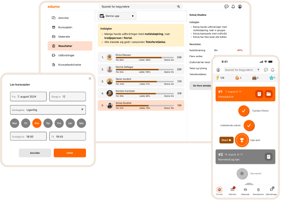Like many teachers in the Edumo community, Alan Fisher didn’t take the traditional route into...
Is Duolingo replacing language teachers?
Duolingo pivoted to an "AI-first" strategy, laying off human experts. This pursuit of scale over substance sparked a fierce backlash from users. The controversy highlights a critical debate: what is the proper role for artificial intelligence in the deeply human endeavor of language learning? Read along to get Edumo's view on the limitations and benefits of AI in language teaching and join the discussion.
Duolingo going AI-first and human-last?
Duolingo has always been about scaling language learning. However, through 2023 and 2024, the language learning app made a series of decisive moves to pivot towards an "AI-first" model. This shift was marked by significant layoffs, 10% by the end of 2023 and continued lay offs during 2024. The AI-first strategy was formally articulated in 2025 in a company-wide email from CEO Luis von Ahn, which was later shared in a LinkedIn post. In it, he announced a strong priority on AI over manual work and celebrated that AI allowed the company to generate nearly 150 new courses in about a year — a task that had previously taken them 12 years for the first 100. However, this pursuit of speed came with a stark admission. The CEO stated that the company will not wait "until the technology is 100% perfect".
This trade-off — efficiency at the expense of quality — seems to have struck at the heart of the user experience and ignited a fierce public backlash. The company's social media channels were flooded with critical comments. The backlash was not merely about job losses; it was rooted in a perceived decline in the product's character and quality. The core of the complaint was a perceived loss of authenticity, a violation of the emotional contract with the audience that Duolingo had cultivated. The company's handling of the crisis only fanned the flames. Attempts to seemingly silence criticism were followed by a series of bizarre, cryptic videos that failed to address the community's concerns. The controversy peaked when von Ahn suggested in a podcast that AI could soon teach better than humans. This comment angered educators and the public alike, cementing the perception of a company dangerously out of touch with the human element of learning. Eventually, facing sustained pressure, Duolingo backtracked. The CEO publicly admitted he "messed up" and attempted to reframe the strategy, stating that he does "not see AI as replacing what our employees do".
AI in language teaching
Users care about the quality of the learning experience, not the operational model behind it. By replacing human creators with AI, Duolingo not only threatened pedagogical quality but also broke the gamified engagement loop that kept users returning. The Duolingo controversy poses a more fundamental question: What is the proper role of AI in an endeavor as deeply human as language learning? To dismiss AI entirely may be a mistake, but to embrace it uncritically is a recipe for disaster. The limitations of a fully automated approach are profound. The user backlash was, in effect, a defense of the human elements of language that AI cannot yet replicate.
- Fluent, but no real understanding: AI systems can generate text that is fluent and grammatically perfect, but struggles with cultural context, idioms, irony, and pragmatics. Research has shown that while AI can learn politeness formulas, it has difficulty navigating the social nuances of speech acts. This is why AI-generated content is frequently described as "bland and uninspired," "overly verbose," and repetitive.
- Engaging, but lack emotional intelligence: A human teacher can perceive frustration, anxiety, or disengagement, and adapt their approach, offer encouragement, or build rapport. This is essential for motivation and completely beyond the capabilities of an AI. Over-reliance on AI in the classroom risks diminishing the crucial human interactions that are vital for developing students' social and communicative skills.
- Convincing, but not trustworthy: AI models inevitably perpetuate the biases contained within the data they trained on. They lack true understanding of the world and are prone to "hallucinations" — producing statements that are plausible and confidently delivered but factually incorrect. This makes them an untrustworthy source of information for learners who lack the expertise to verify the output.
The Duolingo controversy highlights limitations of AI as an autonomous educator. Rather than asking how can AI replace teachers, we should be asking how can AI assist. New generations of tools are starting to do this, helping educators generate lesson plans, create activities, provide interactive exercises, and automatically differentiate and adjust materials.
Edumo and human-first language teaching
At Edumo we don't view language teachers as a bottleneck to be automated away. We see language teachers as the irreplaceable heart of learning and we do not believe AI can or should replace them. If you are a language teacher, we want to assist you, while allowing you to be in control, provide oversight and deliver the human connection and teaching that only you can. We use AI and other means to help reduce time-consuming tasks or to help improve quality or engagement. Here are some current and future planned examples:
- Customize learning materials: Many language teachers spend time on creating or finding and adjusting (supplemental) learning content to their learners. We use AI to help the teacher to produce learning materials faster.
- Media utilization: We currently work on media generation and utilization. We see great promise in the advances in text-to-speech and speech-to-text, and want to make it feasible to use audio and video without needing the teacher to spend a lot of time.
- Ready made materials: We plan on introducing a catalog of learning materials, lesson plans and curricula so you can get packages of ready-made content that you can use directly, adjust or just look at for inspiration.
We have many more ideas to support and assist you as a language teacher that we hope to develop when the above have been developed and polished.
What is your view as a language teacher?
Edumo believes the future isn't about replacing you with AI. It's about you choosing the right tools that respect your expertise, save you time, and allow you to do more of what you do best: teach.
If you are a language teacher, we would like to hear your views on AI in language teaching. Do you worry about being replaced by AI? Have you tried some of the big AI services (ChatGPT, Gemini, Co-pilot and similar) or some tools that utilize AI? What is your experience? We'd love to get your input in the comments; the good, the bad, and the ugly 🤠




